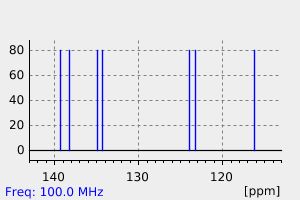1-chloroazulene | 23306-02-7
中文名称
——
中文别名
——
英文名称
1-chloroazulene
英文别名
1-chloro-azulene;1-Chlor-azulen;1-Chlorazulen
CAS
23306-02-7
化学式
C10H7Cl
mdl
——
分子量
162.619
InChiKey
QCJVDXMGGFIJEP-UHFFFAOYSA-N
BEILSTEIN
——
EINECS
——
-
物化性质
-
计算性质
-
ADMET
-
安全信息
-
SDS
-
制备方法与用途
-
上下游信息
-
文献信息
-
表征谱图
-
同类化合物
-
相关功能分类
-
相关结构分类
物化性质
-
沸点:259.6±9.0 °C(Predicted)
-
密度:1.200±0.06 g/cm3(Predicted)
计算性质
-
辛醇/水分配系数(LogP):3.4
-
重原子数:11
-
可旋转键数:0
-
环数:2.0
-
sp3杂化的碳原子比例:0.0
-
拓扑面积:0
-
氢给体数:0
-
氢受体数:0
上下游信息
反应信息
-
作为反应物:描述:1-chloroazulene 在 palladium diacetate potassium phosphate 、 poly(methylhydrosiloxane) 作用下, 以 四氢呋喃 为溶剂, 反应 12.0h, 以92%的产率得到奥苷菊环参考文献:名称:蓝调疗法:通往青金石的高度灵活的路线。摘要:DOI:10.1002/anie.200501276
-
作为产物:描述:参考文献:名称:通过Negishi交叉偶联轻松合成官能化的Azulenes摘要:摘要 描述了一种温和而有效的合成功能化天青石的方法。Negishi将溴azulenes与官能化的芳族,杂环,苄基和烷基有机锌试剂交叉偶联,可得到高产率的取代天青烯。包括乙氧基羰基,氰基,甲氧基,氟,氯和溴在内的官能团具有良好的耐受性。另外,首次描述了通过交叉偶联反应将两个不同的取代基引入a的位置1和3的一锅法。 描述了一种温和而有效的合成功能化天青石的方法。Negishi将溴azulenes与官能化的芳族,杂环,苄基和烷基有机锌试剂交叉偶联,可得到高产率的取代天青烯。包括乙氧基羰基,氰基,甲氧基,氟,氯和溴在内的官能团具有良好的耐受性。另外,首次描述了通过交叉偶联反应将两个不同的取代基引入a的位置1和3的一锅法。DOI:10.1055/s-0034-1379486
文献信息
-
Reactions of azulenes with 1,2-diaryl-1,2-ethanediols in methanol in the presence of hydrochloric acid: comparative studies on products, crystal structures, and spectroscopic and electrochemical properties作者:Miwa Nakatsuji、Yasuhito Hata、Takeshi Fujihara、Kensaku Yamamoto、Masato Sasaki、Hideko Takekuma、Masakuni Yoshihara、Toshie Minematsu、Shin-ichi TakekumaDOI:10.1016/j.tet.2004.05.022日期:2004.7Similarly, reaction of methyl azulene-1-carboxylate (1b) with 2b under the same reaction conditions as 1a gives no product; however, reactions of 1-chloroazulene (1c) and the parent azulene (1d) with 2b under the same reaction conditions as 1a give 2-[3-(1-chloroazulenyl)]-1,1-bis(4-methoxyphenyl)ethylene (4) (81% yield) and 2-azulenyl-1,1-bis(4-methoxyphenyl)ethylene (5) (15% yield), respectively. Along尽管愈创木酚(1a)与1,2-二苯基-1,2-乙二醇(2a)在甲醇中,在60°C的盐酸中,在有氧条件下于有氧条件下反应3小时没有产生任何产物,但1a与1, 2-双(4-甲氧基苯基)-1,2-乙二醇(2b)在与2a相同的反应条件下得到新的乙烯衍生物2-(3-愈创木烯基)-1,1-双(4-甲氧基苯基)乙烯(3),产率为97%。类似地,在与1a相同的反应条件下,将z蓝色-1-羧酸甲酯(1b)与2b反应,没有产物。但是,1-氯杂氮烯(1c)与母体杂氮烯(1d)与2b在与1a相同的反应条件下得到2- [3-(1-氯氮杂烯基)]-1,1-双(4-甲氧基苯基)乙烯(4)(81%收率)和2-氮杂烯基-1, 1-双(4-甲氧基苯基)乙烯(5)(15%收率)。除上述反应外,1a与1,2-双(4-羟苯基)-1,2-乙二醇(2c)和1- [4-(二甲基氨基)苯基] -2-苯基-1,2-乙二醇的反应(2d)在与2b
-
Azulene – Thiophene – Cyanoacrylic acid dyes with donor-π-acceptor structures. Synthesis, characterisation and evaluation in dye-sensitized solar cells作者:Paul Cowper、Adam Pockett、Gabriele Kociok-Köhn、Petra J. Cameron、Simon E. LewisDOI:10.1016/j.tet.2018.04.043日期:2018.5dyes, having D-π-A type structures. These dyes are synthesised using a sulfonium salt cross-coupling reaction. The dyes have been evaluated spectroscopically, electrochemically, crystallographically, and as sensitizers in dye-sensitized solar cells. We propose a rationale for the dyes' spectroscopic properties and performance in cells, based on conformational data derived from their crystal structures
-
Preparation of Azulene-Derived Fulvenedialdehydes and Their Application to the Synthesis of Stable <i>adj</i>-Dicarbaporphyrinoids作者:Timothy D. Lash、Aaron D. Lammer、Aparna S. Idate、Denise A. Colby、Kristen WhiteDOI:10.1021/jo2026977日期:2012.3.2of an azuliporphyrin. Fulvene aldehydes were prepared by reacting an indene-derived enamine with azulene aldehydes in the presence of Bu2BOTf, and azulene dialdehydes similarly reacted to give fulvene dialdehydes. The dialdehydes were condensed with dipyrrylmethanes in TFA/dichloromethane to afford good to excellent yields of dicarbaporphyrinoids with adjacent indene and azulene subunits. These 22-carbaazuliporphyrins已经开发了“ 2 + 2”策略来合成adj -dicarbaporphyrinoid系统。在模型研究中,在盐酸存在下,将z烯基甲基吡咯二醛与二吡咯基甲烷缩合,然后用三氯化铁氧化,以得到适量的a硫卟啉。在Bu 2的存在下,通过使茚衍生的烯胺与a烯醛反应,制得醛BOTf和a二醛类似地反应生成富烯二醛。将二醛与二芳基甲烷在TFA /二氯甲烷中进行缩合,可得到具有相邻的茚基和a基亚基的双碳卟啉类化合物,收率良好。这些22-咔唑卟啉具有显着的变渗特性,并且在质子化时放大了该性质。这些特征归因于具有18π电子离域路径的含tropylium的共振贡献子。质子化的研究表明,Ç -protonation容易发生在内部茚碳,但氘交换还发生在内部薁CH以及在内消旋-位用TFA- d。碳杂卟啉与乙酸银(I)在甲醇或乙醇溶液中的反应也得到了不同寻常的非芳族二烷氧基衍生物。
-
A transition metal catalysed photoreaction. Ferrocene-sensitized photoalkoxycarbonylation of azulene
-
Synthesis of 1,2′-Biazulenes by Palladium-Catalyzed Unusual Homocoupling Reaction of 1-Haloazulenes in the Presence of Ferrocene作者:Taku Shoji、Kanami Miyashita、Takanori Araki、Miwa Tanaka、Akifumi Maruyama、Ryuta Sekiguchi、Shunji Ito、Tetsuo OkujimaDOI:10.1055/s-0035-1561418日期:——pulse voltammetry (DPV). The synthesis of 1,2′-biazulenes was established by palladium-catalyzed homocoupling reactions of the corresponding 1-haloazulenes in the presence of ferrocene. The optical properties of the novel 1,2′-biazulenes were investigated by UV/Vis spectroscopy and theoretical calculations. The redox behaviors of 1,2′-biazulenes were also examined by cyclic voltammetry (CV) and differential
表征谱图
-
氢谱1HNMR
-
质谱MS
-
碳谱13CNMR
-
红外IR
-
拉曼Raman
-
峰位数据
-
峰位匹配
-
表征信息
同类化合物
高密聚乙烯
香叶醇
顺式3-甲基-2-己烯
顺式-5-癸烯
顺式-5-甲基-2-己烯
顺式-5-庚烯-1-炔
顺式-4-癸烷
顺式-4-甲基-2-戊烯
顺式-4-甲基-2-戊烯
顺式-3-癸烯
顺式-3-甲基-3-己烯
顺式-3-甲基-2-庚烯
顺式-3-戊烯-1-炔
顺式-3,4-二甲基-3-己烯
顺式-3,4-二甲基-2-戊烯
顺式-3,4-二甲基-2-戊烯
顺式-2-甲基-3-己烯
顺式-2-壬烯
顺式-2-丁烯-D1
顺式-1.1.1-三甲基-2-丁烯
顺式-1-甲基-2-环丙基乙烯
顺式-1-甲基-2-乙烯基环戊烷
顺式-1-环戊基-1-辛烯
顺式-1-氘代-3-甲基-1-丁烯
顺式-(9ci)-2,3,3a,7a-四氢-4-(1-甲基乙基)-1H-茚
顺式-(2-丁烯基)环丙烷
顺式,顺式-2,4-己二烯
顺-环辛烯
顺-9-二十一碳烯
顺-6-十三碳烯
顺-5-甲基-1,3,6-庚三烯
顺-4-辛烯
顺-4-壬烯
顺-3-辛烯
顺-3-甲基-2-戊烯
顺-3-壬烯
顺-3-十三碳烯
顺-2-辛烯
顺-2-癸烯
顺-2-戊烯
顺-2-庚烯
顺-2-己烯
顺-2-丁烯
顺-2,2-二甲基-3-己烯
顺-1,3-戊二烯
顺,顺-1,9-环十六烷二烯
顺,顺,顺-环癸-1,3,5-三烯
间戊二烯
间二(4-吡啶基)苯
镁,二-2-丁烯基-







